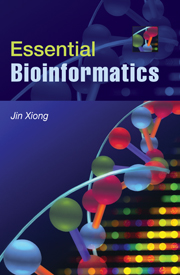Book contents
- Frontmatter
- Contents
- Preface
- SECTION I INTRODUCTION AND BIOLOGICAL DATABASES
- SECTION II SEQUENCE ALIGNMENT
- SECTION III GENE AND PROMOTER PREDICTION
- SECTION IV MOLECULAR PHYLOGENETICS
- SECTION V STRUCTURAL BIOINFORMATICS
- 12 Protein Structure Basics
- 13 Protein Structure Visualization, Comparison, and Classification
- 14 Protein Secondary Structure Prediction
- 15 Protein Tertiary Structure Prediction
- 16 RNA Structure Prediction
- SECTION V GENOMICS AND PROTEOMICS
- APPENDIX
- Index
- Plate section
- References
16 - RNA Structure Prediction
Published online by Cambridge University Press: 05 June 2012
- Frontmatter
- Contents
- Preface
- SECTION I INTRODUCTION AND BIOLOGICAL DATABASES
- SECTION II SEQUENCE ALIGNMENT
- SECTION III GENE AND PROMOTER PREDICTION
- SECTION IV MOLECULAR PHYLOGENETICS
- SECTION V STRUCTURAL BIOINFORMATICS
- 12 Protein Structure Basics
- 13 Protein Structure Visualization, Comparison, and Classification
- 14 Protein Secondary Structure Prediction
- 15 Protein Tertiary Structure Prediction
- 16 RNA Structure Prediction
- SECTION V GENOMICS AND PROTEOMICS
- APPENDIX
- Index
- Plate section
- References
Summary
RNA is one of the three major types of biological macromolecules. Understanding the structures of RNA provides insights into the functions of this class of molecules. Detailed structural information about RNA has significant impact on understanding the mechanisms of a vast array of cellular processes such as gene expression, viral infection, and immunity. RNA structures can be experimentally determined using x-ray crystallography or NMR techniques (see Chapter 10). However, these approaches are extremely time consuming and expensive. As a result, computational prediction has become an attractive alternative. This chapter presents the basics of RNA structures and current algorithms for RNA structure prediction, with an emphasis on secondary structure prediction.
INTRODUCTION
It is known that RNA is a carrier of genetic information and exists in three main forms. They are messenger RNA (mRNA), ribosomal RNA (rRNA), and transfer RNA (tRNA). Their main roles are as follows: mRNA is responsible for directing protein synthesis; rRNA provides structural scaffolding within ribosomes; and tRNA serves as a carrier of amino acids for polypeptide synthesis.
Recent advances in biochemistry and molecular biology have allowed the discovery of new functions of RNA molecules. For example, RNA has been shown to possess catalytic activity and is important for RNA splicing, processing, and editing. A class of small, noncoding RNA molecules, termed microRNA or miRNA, have recently been identified to regulate gene expression through interaction with mRNA molecules.
- Type
- Chapter
- Information
- Essential Bioinformatics , pp. 231 - 240Publisher: Cambridge University PressPrint publication year: 2006



